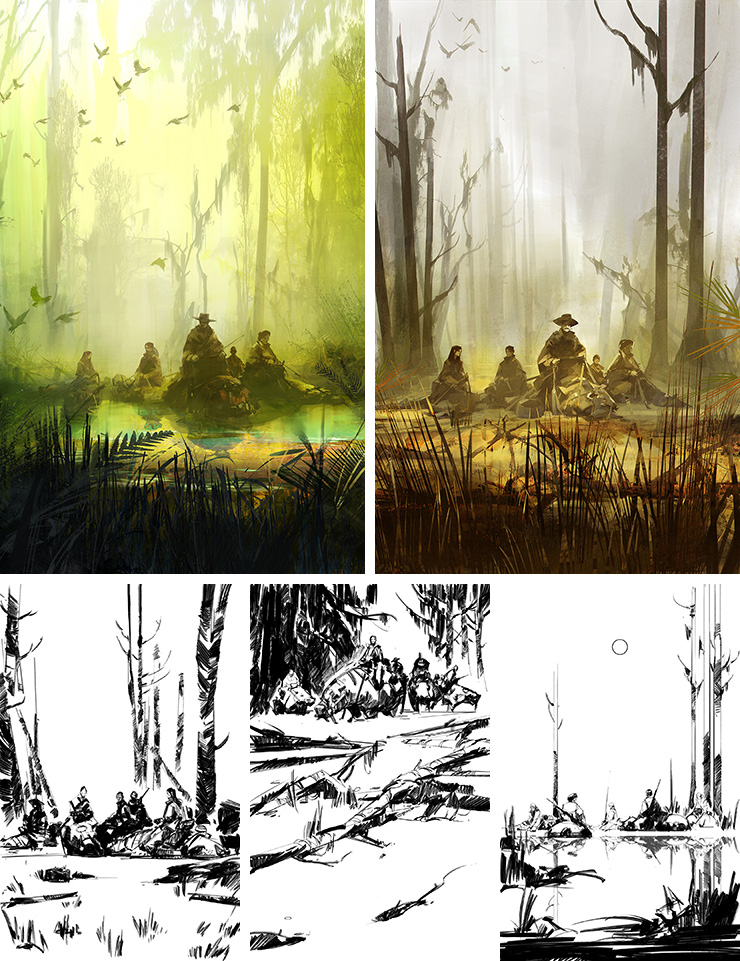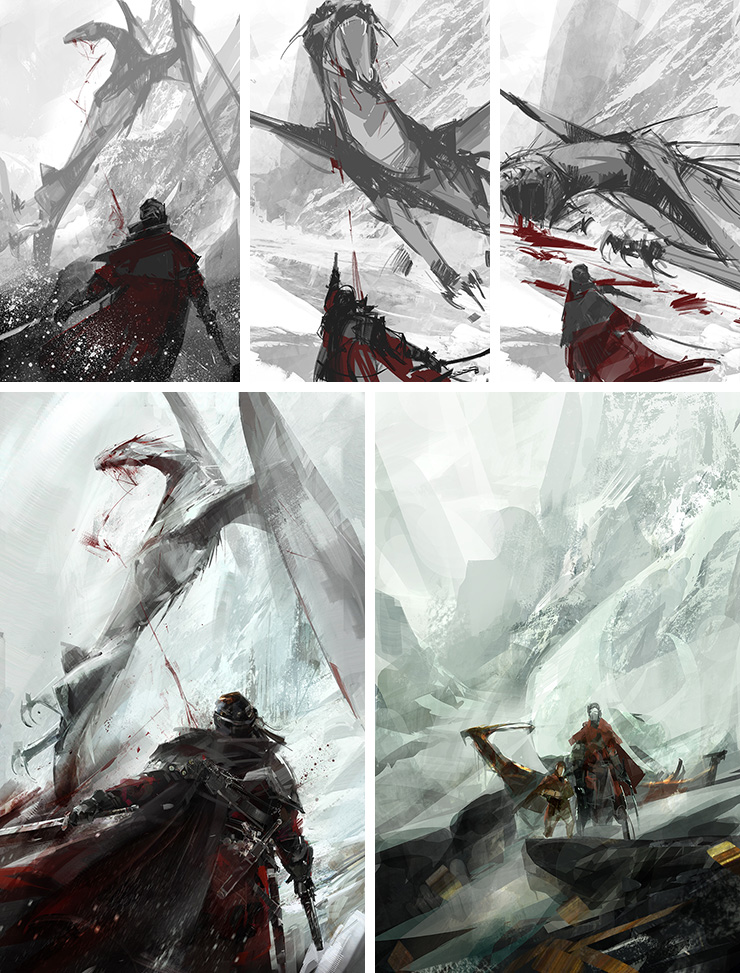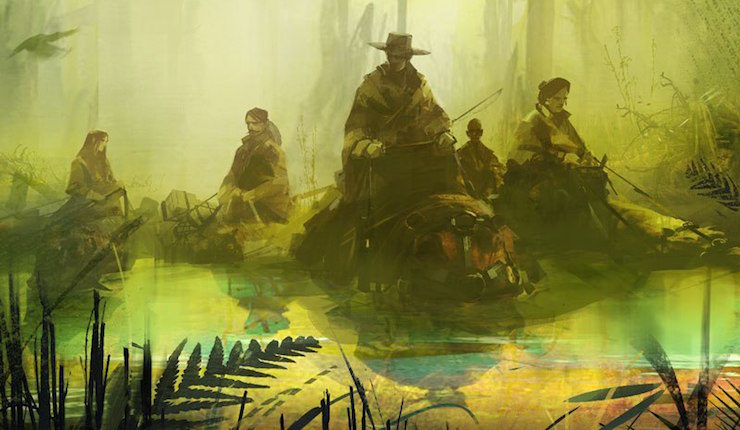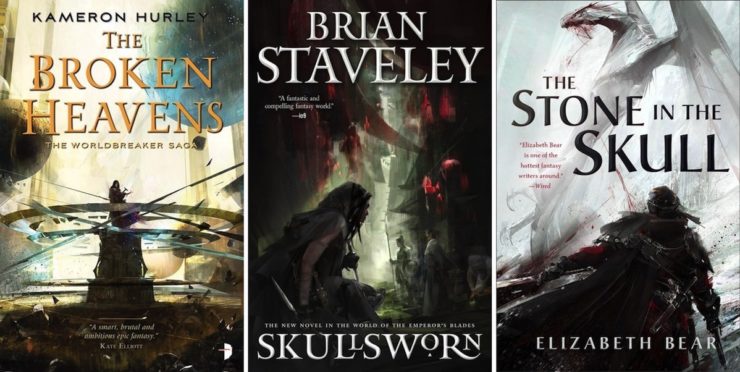Welcome to Art of SFF—a new column covering the best and brightest science fiction and fantasy artists. From newcomers to legends, Art of SFF pulls back the curtain to introduce you to the people behind your favourite book covers, films, and video games, and SFF-influenced art of all kinds.
This month, we chat with the prolific Richard Anderson.
“I’ve always been intrigued by science fiction and fantasy,” revealed Richard Anderson, a concept artist and illustrator whose list of clients includes Tor Books, Marvel Studios, and Disney. In fact, you can’t turn around in the science fiction and fantasy (SFF) aisle at the bookstore without bumping into one of his covers. From Kameron Hurley to Brian Staveley and Elizabeth Bear, he’s worked with many of today’s most exciting science fiction and fantasy writers, and his style is becoming ubiquitous with modern SFF. It’s no coincidence—SFF dominated his childhood. It all began when his older brother encouraged him to watch classic fantasy films, such as Arnold Schwarzenegger’s hilariously dubbed Conan and Ridley Scott’s classic Legend. “Those films sparked my fascination with worlds outside of ours, inspiring me to draw my own. I love the creativity and imagination of going beyond the world we know—into my own ‘fantasy.’”
Originally from Montana, Anderson moved to Seattle, WA in his early 20s, to pursue a career in art. The Pacific Northwest is a maelstrom of SFF talent, and it was there that he gained attention for his raw, colourful concept art work on ArenaNet’s Guild Wars series. Alongside fellow ArenaNet artists Kekai Kotaki (The Complete Malazan Book of the Fallen by Steven Erikson) and Daniel Dociu (James S.A. Corey’s The Expanse), Anderson helped popularize a style of SFF art that is tense and mature, eschewing the glossy tropes of yesteryear, while adopting a more modern aesthetic for SFF novels. Now based in London, UK, Anderson works for Rocksteady Studios, developers of Batman: Arkham Knight, and continues to split his time between the publishing and video game industries—even dipping his toes into the film industry as a Senior Concept Artist on films such as Guardians of the Galaxy and Gravity. A man of many hats, Anderson’s work has earned many accolades, including multiple inclusions in Spectrum and feature articles on Kotaku and io9.
His unique style is well-suited to the recent upsurge in grim and/or dark fantasy made popular by George R.R. Martin, Kameron Hurley, and Mark Lawrence. Among many impressive clients, Anderson has illustrated covers for many popular SFF publishing imprints, including Orbit, Random House, Tor, and Angry Robot—making him one of the most prolific and recognizable cover artists working today.
“His covers are dynamic and gorgeous,” said Sarah Gailey, whose debut novella, River of Teeth, features one of Anderson’s most evocative illustrations. “They render a world in broad, luminous strokes that leave the reader to fill in a few of the finer details without neglecting visual interest or specificity.

“When Tor.com told me that he’d be the one to do the covers for River of Teeth and Taste of Marrow, I just about jumped out of my skin with excitement—his art communicates well-grounded action, movement, and above all, a sense of tension that you simply can’t get anywhere else. Both of the covers he’s done for these books have brilliantly reflected the character of the writing and the intention of the prose. He’s a dang genius.”
When approaching a fresh canvas for a book cover, Anderson has to separate his own personal taste and style from the project’s commercial goals. A cover for a Sarah Gailey novella needs a different approach than a cover for an Elizabeth Bear novel, which in turn needs a different approach than concept art for a video game or film. Finding that balance can be tricky, Anderson admits. “Sometimes the requests that come in from a client can be full of specific ideas, which can block some of what I want to do creatively or artistically. However, at the end of the day, this is what being a professional is about—being able to deliver what is requested and also applying your artistic intuition to the piece and finding a solution that appeals to as many people as possible. (Or trying to at least.) I try to make things tight enough for the reader to recognize ideas from the book, but also give them a launching pad for their own ideas and imagination.”
Every artists starts somewhere, and Anderson can look at his journey from aspiring artist to professional and recognize many of the influences that have helped him refine his distinct style. “During the creation process,” said Anderson, “artists tend to subconsciously deconstruct and mimic art that they have seen before and were (excuse the pun) drawn too. Starting from there and adding a whole lot of studying and non-stop drawing with different tools, I began to develop and refine my own style.” Anderson’s long list of influences includes: Bernie Fuchs, Robert Heindel, Ashley Wood, Mike Mignola, Jeffrey Catherine Jones. “The lists goes on and on.”
Despite his popularity, Anderson is still a newcomer to the SFF art scene compared to some of those artists he’s working alongside—but there’s room for everybody, he insists. “SFF are more popular now than ever before, at least from a mainstream perspective,” he said. “Though there will always be a place for simple and iconic imagery on covers, I think that popularity will lead to people wanting to see more expressive and unique graphics and illustrations that set books apart from one another. Like what we saw in the ‘60s.”

It’s not just the tastes of readers that are changing, Anderson said, but the interests and backgrounds of new writers, too. “A new generation of authors is growing up in this Game of Thrones/Marvel Extended Universe/anime generation, and the books they’re writing are going to have a huge impact on the direction of the covers hitting bookstore shelves.”
Anderson has worked with many of today’s most popular genre authors, but that doesn’t stop him from wanting to get his hands on some of SFF’s most iconic characters. “I know it’s a cliché, but I started reading A Song of Ice and Fire in 2003 and just loved it so much. I’d love to do a cover for Martin’s books. I’d also love to spend time with Joe Abercrombie’s characters—Inquisitor Glokta, The Bloody Nine—they are so dark and funny. To top it off, getting to illustrate Mike Mignola’s Hellboy would be the coolest thing ever!”
You can find more of Richard Anderson’s art, including many sketches and in-progress snapshots, on his official website, Tumblr, and Instagram.
Aidan Moher is the Hugo Award-winning founder of A Dribble of Ink, and author of Tide of Shadows and Other Stories and “The Penelope Qingdom”. He regularly contributes to Tor.com, the Barnes & Noble SF&F Blog, and several other websites. Aidan lives on Vancouver Island with his wife and daughter.












I am very excited for this series!
This is an exciting new series. Looking forward to more.
I like your write-up, Aidan. I only wish I enjoyed Anderson’s art as much as you. I can’t help but find it blurry and unfinished. The man clearly has skill, but I struggle to find a difference between the quality of the sketches and the finished art.
I find his covers preferable to graphic design type covers, but not by much. There’s also this strangely flat look to some of his covers which I think is a result of painting digitally using a lot of flat geometric chunks of colour. I’m not sure how else to describe it.
Here’s hoping some of my favourite artists make an appearance in this series!
@@@@@Gina — Thanks! I’m excited to finally have it off the ground. Lots of fun stuff to come.
@@@@@ swario — I plan to cover artists of all different styles, so hopefully soon you’ll see someone you love. Who would you like to see covered?
@Aidan Moher, Oh man. There are so many! Frazetta, Charles Vess, Michael Whelan, Larry Elmore, Keith Parkinson, Matt Stawicki, John Harris, Darrell K. Sweet, Boris Vallejo, John Howe, Chris Foss, Paul Youll, and I could go on.
My notable blind spots are female artists and more contemporary artists. I buy a lot of used books so the art I tend to see is on older books or older editions.
Will you be listing books where the artists’ work can be purchased separate from whatever book they’re covering? I’ve got a few at home and they’re usually pretty great to read and look at. I recently read one of Whelan’s collections and he mentions doing professional level work while his art was in a cast. IN A CAST! It’s mind blowing. I couldn’t see any difference in quality from his few in-a-cast covers and those he did prior to his injury.
Another question. Will you be including comic book artists on this list? People like Wally Wood and Al Williamson?
Again, pretty excited about this one and I hope to discover some new-to-me artists.
@swario — That’s great! My intention is to highlight new/up-and-coming artists alongside masters of the field, so people like Whelan, Howe, Vess, etc. are definitely on my radar. I also hope to be able to introduce readers to new (to them) artists along the way, so fingers cross that I can help you find some of your new favourites!
That’s a great idea to include collections/art books. I’ll keep that in mind for future iterations where the artist has made those available. I do try to link to their online stores, if they have them.
I would like to cover a broad swathe of artists, so comic book illustrators are definitely a possibility.
Anderson’s work is far and away my favorite in SFF at the moment. I think the unfinished, suggestive look works particularly well for the genre. I pre-ordered River of Teeth because of the cover. Well, that and the hippos. Who doesn’t want a fantasy about hippos.
Small correction: the infamously-dubbed Schwarzenegger film was Hercules in New York, not Conan the Barbarian.
I would like to see a profile of my personal favorite fantasy cover artist, Thomas Canty. His work is so unique I would know it anywhere. Even though they say you can’t judge a book by its cover, I never met a Canty cover I didn’t like. I have bought books just because they had one of his covers, and it seems I always love the story. I’m sure there are lots of people who appreciate his great talent.